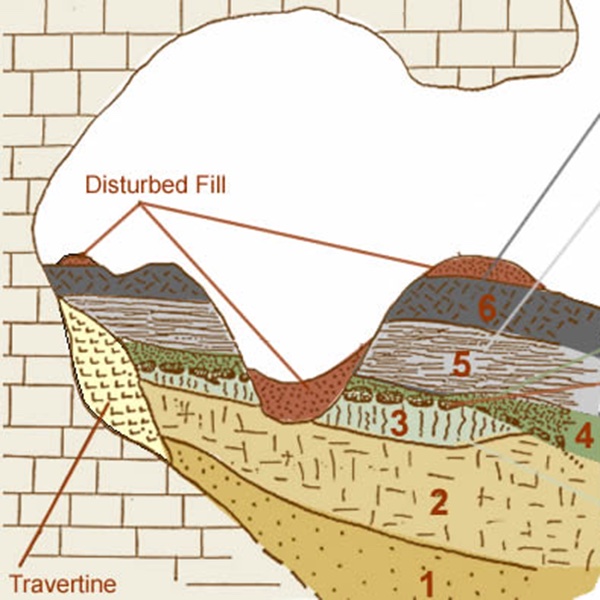Kincaid Creatures

Download lesson plan and included materials
Subject: Social Studies and Science
Grade: 4th Grade
Author: Carol Schlenk, revised by Jason Terry and Mary Rodriguez (2023)
Time Duration: One or two 45-minute class periods
Objective: To illustrate how archeologists use stratigraphy to help determine environmental changes in a specific area since the Pleistocene Era, and to point out that these changes have affected the animals living in that area.
TEKS: Social Studies, Grade 4
- (1A), explain the possible origins of American Indian groups in Texas
- (6A), identify, locate, and describe the physical regions of Texas (Mountains and Basins, Great Plains, North Central Plains, Coastal Plains), including their characteristics such as landforms, climate, vegetation, and economic activities
- (7A), explain the geographic factors such as landforms and climate that influence patterns of settlement and the distribution of population in Texas, past and present
- (19C), organize and interpret information in outlines, reports, databases, and visuals, including graphs, charts, timelines, and maps
- (19D), identify different points of view about an issue, topic, historical event, or current event
- (21A), use social studies terminology correctly
Science, Grade 4
- (1F), construct appropriate graphic organizers used to collect data, including tables, bar graphs, line graphs, tree maps, concept maps, Venn diagrams, flow charts or sequence maps, and input-output tables that show cause and effect
- (7A), examine properties of soils, including color and texture, capacity to retain water, and ability to support the growth of plants
Materials:
- www.texasbeyondhistory.net/kincaid
- Kincaid Shelter painting (included)
- Kincaid Shelter Stratigraphy student handout (2 pages – included)
- Kincaid Creatures Magic Squares student handout (included)
- Kincaid Creatures Magic Squares teacher answer key (included)
Activities and Procedures:
Part 1
Step 1: Ask students to brainstorm nocturnal and diurnal wild animals they see in their neighborhoods. Make a list on the board as students name the animals.
Step 2: Inform students that they will be learning about the remains of animals found near a cave where humans lived 13,000 years ago. The cave was located in Southwestern Texas near the Sabinal River.
Step 3: Display painting of the Kincaid Shelter. Have students point out details and make inferences about what they see in the painting.
Step 4: Advise students if that had they lived in Texas during the "Great Ice Age" (Pleistocene Era), some 13,000 years ago, they would have seen a much different variety of animals than they see today.
Step 5: Distribute the "Kincaid Shelter Stratigraphy" handout (page 1) and display the stratigraphy diagram. Read the handout with students and explain that archeologists record their site findings in several ways, one of which uses stratigraphy. Point out that the zones or layers (also called strata) are numbered.
Step 6: Have students work with a partner or in small groups to answer the questions on page 2 of the "Kincaid Shelter Stratigraphy" worksheet. When done, have students volunteer to share their answers to questions #1, 7, & 8 with the class.
Step 7: Explain that during the next class period, students will search a Kincaid Shelter website for animals whose remains were found in different layers of the Kincaid Shelter site. They will then use the animal names to solve a puzzle.
Part 2
Step 1: Remind students that in Part 1 of the lesson, they discussed wild animals found in their neighborhoods and were introduced to the stratigraphy of Kincaid Shelter, where remains of many wild animals were found.
Step 2: Distribute the "Kincaid Creatures Magic Squares" handout. Explain to students that in the grid they will see nine Magic Squares, each containing the name of one of the animals found at Kincaid Shelter. Below the grid they will see descriptions of the animals and will match the number of each description to the corresponding animals’ name in each "magic" square. Explain that students can check their work by adding up the numbers in the rows of squares both horizontally and vertically. Each row should add up to the same "magic" number. If their rows don’t add up to that number, they have an incorrect answer and must check their work. When their numbers add up correctly, they have discovered the "magic" number, which they will record on the worksheet.
Step 3: Have students play "Meet the Critters" (www.texasbeyondhistory.net/kincaid/kids/index.html) or "Time Travel to an Ancient Rock Shelter" (www.texasbeyondhistory.net/kincaid/kids/timetravel.html) to learn more about the animals of Kincaid Shelter.
Closure: Ask students this question: How can archeologists help us better understand the ways humans and animals interacted in the past and how animals might have become extinct over time?
Assessment: Students will correctly complete the "Kincaid Shelter Stratigraphy" handout questions and the "Kincaid Creatures Magic Squares" handout.